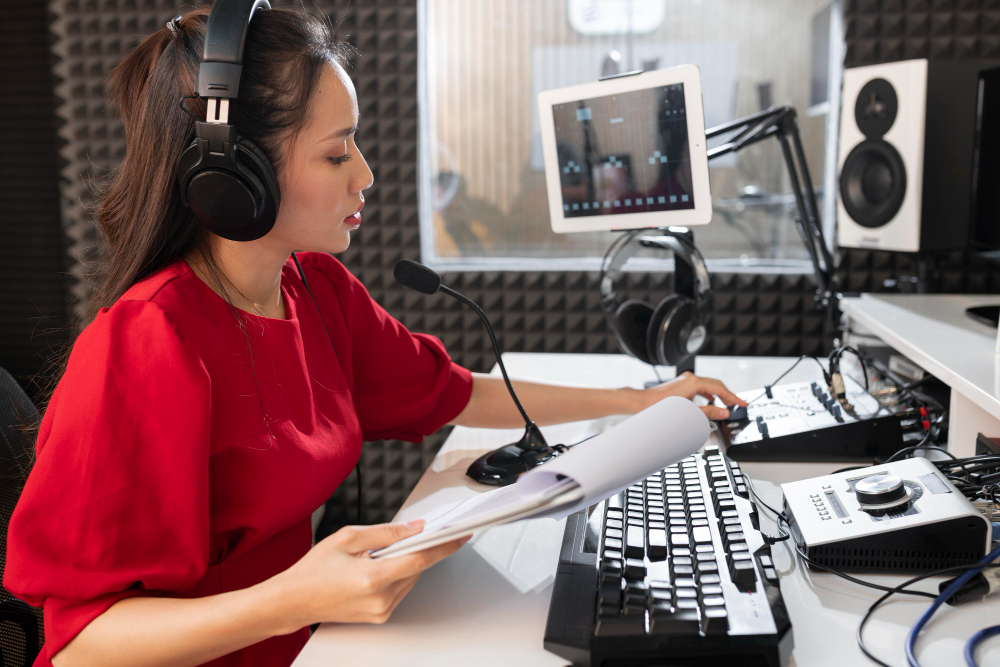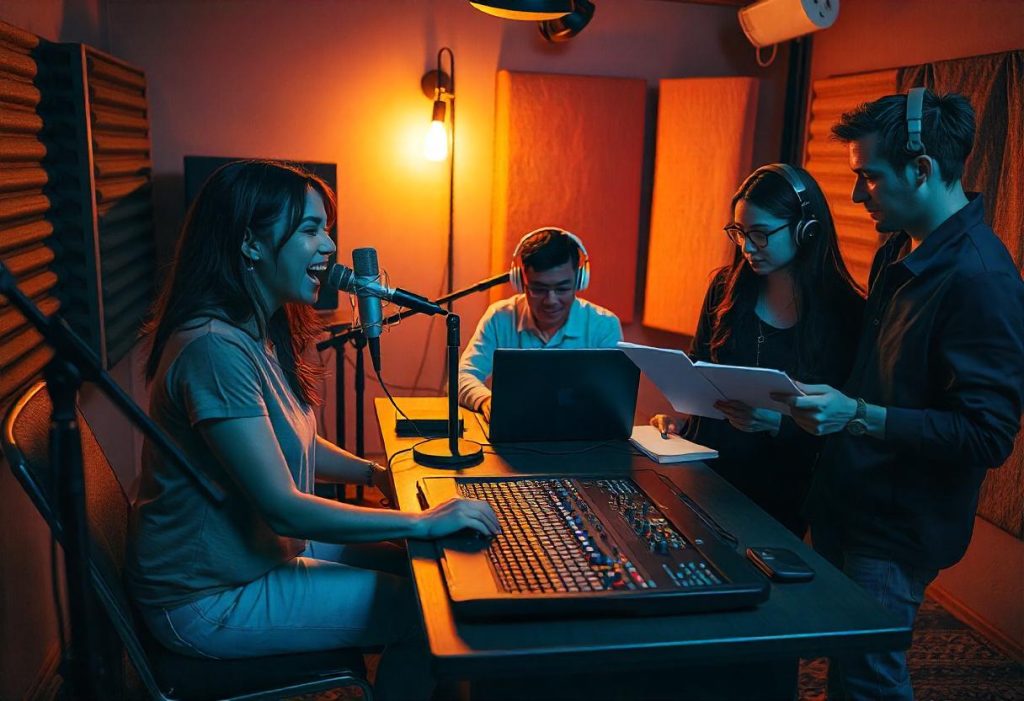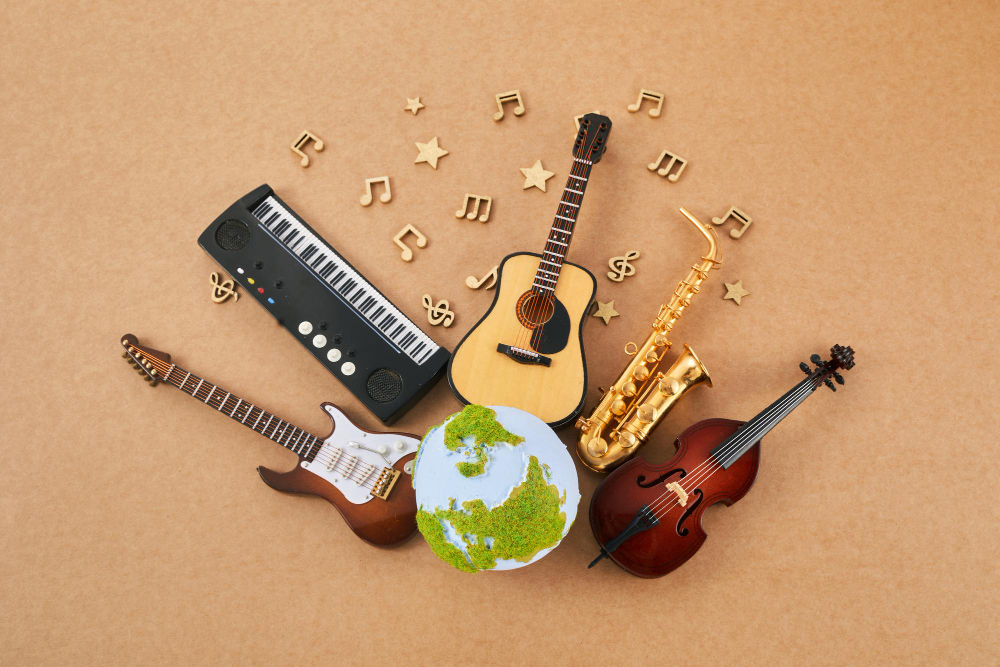Sound Design Tips for Podcasts: Make Your Show Stand Out
Sound design for podcasts is more than just editing and background music – it’s all about creating the right vibe to connect with your target audiences.
Have you ever come across podcasts with hundreds and thousands of views and streams? What do you think sets them apart? Imagine listening to a podcast where you have to strain your ears and really pay attention to understand and differentiate between each sound. Now imagine one where it all transitions smoothly and you are drawn to the life-like sound it echoes in the room. Even when the content is similar, how realistic a podcast sounds can make all the difference.
Sound design enhances the quality of the podcast, allowing the listener to focus and deep-dive into the content and enriching their experience. Starting with a dedicated space for recording – soundproofed and quiet, like a – and good-quality yet affordable gear, you can up your podcast game in no time.
If you want to be an expert sound designer or have a podcast of your own, take some time to learn the basics of sound design. From ensuring clean audio, balancing the audio levels, and adding sound effects to layering different sounds to create a sense of depth, using different mic techniques, and making the most of the pauses in between, you can make the final product as good as the idea you came up with.
Do you want free career counseling?
Ignite Your Ambitions- Seize the Opportunity for a Free Career Counseling Session.
- 30+ Years in Education
- 250+ Faculties
- 30K+ Alumni Network
- 10th in World Ranking
- 1000+ Celebrity
- 120+ Countries Students Enrolled
The difference between an average and a great podcast is good sound design. It can make your show truly memorable and engaging.
This article will walk you through some practical tips to help you record podcasts that sound professional and set your work apart!
Why is Sound Design Important in a Podcast?
Say you are listening to a story, and the podcaster decides to add ASMR, such as rain, birds, or even a character walking. How interesting would that be?
Book Now →
A well-designed background score and perfectly synced audio create the right mood and guide how the listeners will feel throughout the show. It allows listeners to fully connect with the content irrespective of whatever platform they are listening on.
Read Also: Indian Classical Vocal v/s Western Vocal – Understanding the Key Differences
One of the most important elements of a podcast is good sound design. It enhances the audio quality, makes the show more interesting, and improves the listeners’ experiences, creating the perfect first impression.
Do you want free career counseling?
Ignite Your Ambitions- Seize the Opportunity for a Free Career Counseling Session.Sound design complements the structure and theme of a podcast, ties together the entire show, makes it consistent and cohesive, and creates an immersive experience.
Good sound design makes the show more credible, and on-point intros and outros with meaningful sound effects help build a unique brand identity. It can reinforce the brand value, emphasize the tone of voice, and create a loyal listener base.
5 Essential Sound Design Tips For Podcasts That Stand Out
Mastering sound design for podcasts will allow you to confidently experiment with the medium, executing novel ideas and adding a professional touch to the show. From creative ASMRs to carefully utilized pauses and voice modulations – sound is the backbone of a good podcast.
Learn how to manipulate the equipment and use different mic techniques to capture the real sounds, record and incorporate foley sound effects, layer different audios to add drama to a podcast, and get the listeners hooked to it –
- Set Up A Dedicated Space For Recording
The first step to perfecting sound design is to set up a dedicated space where you record the podcast. You don’t need a fancy studio in the beginning, just pick out a room that fits the requirements. Having a specific space for recording will save you the time needed to set up afresh every time you record.
You will need a quiet and preferably soundproofed room with a reduced echo for the best effects. If you don’t have a permanent set-up yet, use a storeroom, bathroom, or even a closet for a better sound effect. For video podcasts, ensure there are adequate natural lighting or light fixtures that illuminate the room in a way suitable for the show.
Before you press record, don’t forget to try out the equipment in the room. Test your microphones and headphones, see where you can place the mic stands, and gauge if the gear serves its purpose in the space you have selected. This will ensure clean recording and good audio quality in the final product.
- Use Good-Quality Equipment
Investing in good-quality equipment will save you a lot of time in audio clearing and balancing in post-production. It plays an integral role in achieving a professional-level sound design for podcasts that resonates with the listeners.
Get good-quality microphones and headphones that capture the sound accurately, minimize background noise, reproduce the sound with minimal distortion, and block outside noise. These allow you to record precise sounds and understand the inconsistencies better while editing, leading to better outcomes.
Read Also: Sampling vs. Synthesizing: Techniques Every Producer Should Know
Make sure you use a mic stand to get balanced audio and avoid unwanted noise while moving or handling the mic mid-podcast. Soundproofing materials for the studio, an audio interface that fits your needs, and external storage devices are key to a hassle-free recording and editing process.
Editing is as important as recording – it adds a finesse, improves the quality of the final product, and lets the listeners enjoy the show without getting distracted by any abnormality in the audio. A computer with a good processor and industry-standard DAW software can be a game changer, adding value to your work and saving a ton of time.
- Make Sure The Audio is Clean
There are two ways to ensure clean audio in your podcast – you can create a studio with professional-grade gear to ensure the recorded sound is highly accurate and as close to the natural sound as possible, or you can edit and clean the audio out in post-production. While the latter is a time-consuming task that requires you to thoroughly listen and analyze each section for hours, the former is an efficient way; and you can always fine-tune and get rid of the minimal inconsistencies in editing.
So how do you record clean audio? Start with soundproofing the room – use foam, acoustic boards, vinyl, or thick rugs and blankets. Add foam boards to make the walls more dense and prevent any unwanted noise from entering the room.
Adjust your microphones, fix them on a stand, and use dynamic and direction mics to control and eliminate background noise. Add pop filters and monitor and adjust audio levels while recording for a cleaner and more accurate sound.
Don’t forget to test the equipment before you start recording. It might not seem as important, but testing the gear would help you prevent errors and achieve a smoother flow for your podcast.
Read Also: How AI is Changing the Future of Music Production

- Add Sound Effects And Layer Different Sounds
Incorporating subtle sound effects for podcasts – foley sound effects like footsteps, wind, or doors creaking – can foster engagement and get the listeners hooked to it. It creates an immersive feeling where the listener is transported to the world the show is trying to create using a variety of sounds. You can also use ASMRs to add a sensory layer that further enhances the experience.
When you are listening to an audio podcast, you still want to enjoy the sensory experiences that make it realistic. And in real life, you don’t always hear one sound at a time, you hear a bunch of sounds – people talking, traffic, birds, distant music – blended into one another, and yet, not making complete chaos.
Read Also: Top 7 Creative Courses to Spark Inspiration in Young Minds
Sound designers often layer different sounds and effects to create a life-like feeling and evoke the intended emotions in listeners. They can create unique and novel sounds in the process, while the layering adds depth and drama.
When you are recording a podcast, you will most likely encounter pauses and occasional silences. The key to a good sound design is to embrace these pauses instead of filling them with music and sound effects. Optimizing the silence makes the flow feel more natural and gives audiences a moment to ponder – giving the podcast a professional glow-up.
- Focus on Fine-Tuning and Editing The Podcast
The final step in sound design for podcasts is editing and fixing any irregularities. This is the part where you edit out any inconsistencies, finalize creative sound effects, and make sure the transitions are smooth and seamless.
Use noise reduction tools to eliminate background noises captured during recording and other audio distractions. This is an important step to clean up the audio.
Balance the volumes to create a pleasant listening experience. Make sure there is harmony in how much background music and sound effects you are using. Cut out anything that overpowers the actual content to make every subtle, little sound blend smoothly with one another, making a perfect composition. Use EQ and audio enhancements to reduce any harshness and polish the final audio.
Read Also: Top Essential Tools That Every Aspiring Producer Needs in Music Production 101?
Before you finalize, test the sound to double-check anything that you might have missed in the first go. Testing and listening on different devices will rule out any remaining inconsistencies, make the audio compatible with multiple devices and systems, and improve the overall quality of the podcast. You can also take a second opinion at this stage to lock all the changes in and deliver a high-quality podcast that enriches the listening experience and makes a mark on the audiences’ minds.
Conclusion
If you are looking for a way to make your podcast stand out, a good sound design is the way forward! As a beginner, you need to get acquainted with the basics of sound design for the podcasts to be more cohesive and put together. It would instantaneously elevate the quality of the show, making it both memorable and credible, and adding a little professional ‘kick’.
Set up a space dedicated to recording and ensure all the equipment you are using is up to the mark and of good quality. Using the right techniques, adding silences, and thorough editing and fine-tuning with layered sound effects and engaging music will do all the magic you need for an awesome podcast.
Join a professional sound designing course to understand the nuances of sound design and make a successful and rewarding career out of it. AAFT Noida offers various degree and diploma programs with all the essential tools and resources, and access to its state-of-the-art labs and studios to master sound design and get a headstart in your career. With a curriculum that meets industry standards, hands-on training, and expert-guided workshops and lectures, you can make a seamless transition to the professional space and bring your creative ideas to life.

AAFT has been providing the world with limitless creativity and expression since 1993! Through a dynamic and industry-driven curriculum, AAFT provides engaging and captivating articles to persuasive blogs and empowers its readers to explore diverse avenues of creative media education-related content.






